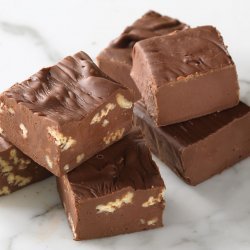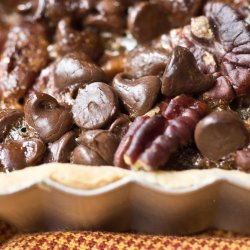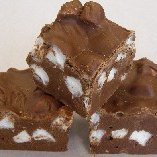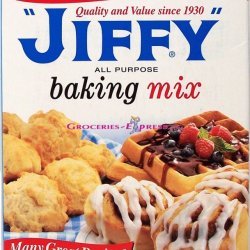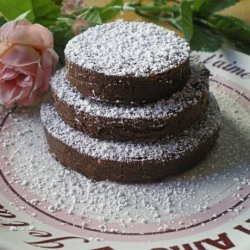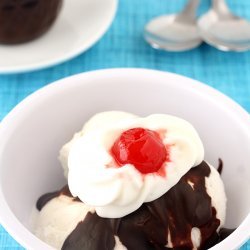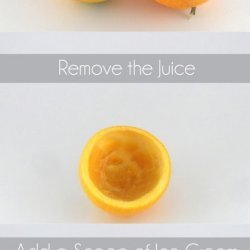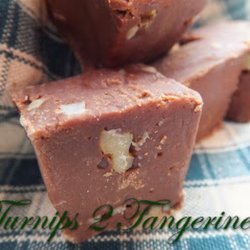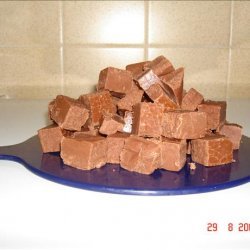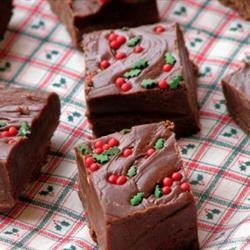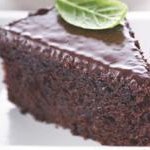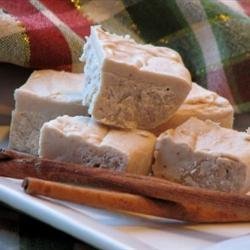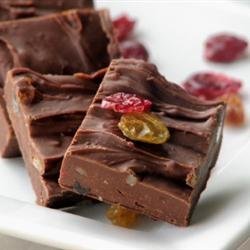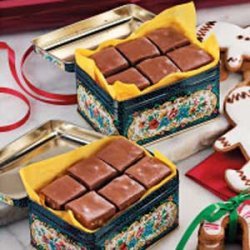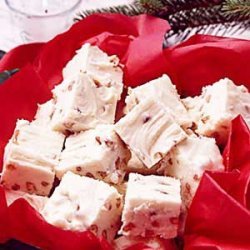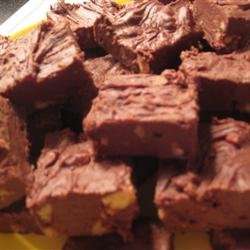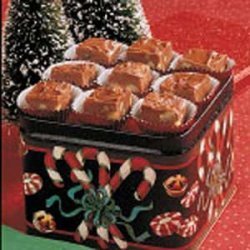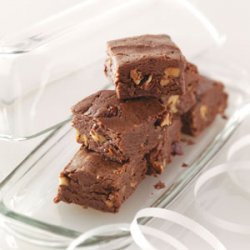Directions:
- In a 3- to 4-quart heavy-bottomed pan over medium-low heat, stir sugar, cream, and corn syrup, continually scraping the bottom of the pan with a heatproof flexible spatula, until sugar is completely dissolved, about 15 minutes. Stir in unsweetened and bittersweet chocolate until melted. Increase heat to medium and bring mixture to a simmer.
- Cook, occasionally stirring mixture and brushing down sides of pan with a wet pastry brush, until mixture reaches 235° on a candy thermometer. Remove from heat and pour into the bowl of a standing mixer or another large bowl. Add butter and vanilla but do not stir; insert candy thermometer and let mixture stand undisturbed until cooled to 110°, 1 1/2 to 2 hours.
- Line a 9-inch square pan with foil; lightly butter foil. With the paddle attachment of standing mixer or a sturdy wooden spoon, beat the chocolate mixture vigorously (on high speed if using mixer; reduce speed if motor starts to labor) until mixture thickens and loses its glossy sheen, about 5 minutes with a mixer, about 10 minutes by hand. Scrape into pan, smooth top, and chill until firm to the touch, at least 2 hours, or up to 1 day.
- Lift foil to remove fudge from pan; cut fudge into 1-inch squares. Store cut fudge airtight in the refrigerator up to 1 week. To keep longer (up to 1 month), wrap uncut fudge airtight and chill; cut into squares as you want to use it. Serve at room temperature.
- Candy basics:
- Before you begin, read the recipe all the way through and assemble all the tools and ingredients you will need. Many candy recipes require that you act quickly once the sugar syrup reaches the desired temperature. Use care when working with hot sugar syrup, as it can cause severe burns.
- Choose the right pans. Heavy-bottomed stainless steel pans are best for cooking sugar mixtures. Thin, lightweight pans tend to conduct heat-and cook sugar syrup-unevenly.
- Use a candy thermometer when called for. They measure temperatures up to 400°. You'll find them in the kitchen-gadget section of many supermarkets, priced between $10 and $20.
- Submerge the bottom of the thermometer completely in the sugar syrup to get an accurate reading. Using a narrow pan with tall sides makes the mixture deeper, but, if necessary, you can gently tilt a shallower pan to submerge the thermometer bottom.
- Melt chocolate gently for best results. If chocolate gets too hot, it may not set properly and will develop bloom (white streaks) on the surface when stored. Stirring chopped chocolate in a pan or bowl over hot, not simmering, water maintains an even, low temperature, resulting in glossy, firmly set chocolate.
- Fudge pointers:
- Dissolve the sugar completely over low heat (step 1) before bringing the mixture to a simmer. Using superfine sugar, also sold as baker's sugar, makes this easier. To check whether the sugar has dissolved, scrape the pan bottom with a heatproof spatula, pull the spatula up, let the syrup on it cool for a few seconds, then rub a drop between your fingers. If you can feel grains of sugar, it hasn't dissolved yet.
- Prevent sugar crystals from forming on the sides of the pan in step 2 by brushing down the sides with a wet pastry brush a few times.
- Let the mixture cool to lukewarm (exactly 110°) before beating it (step 3); otherwise, the fudge may stiffen and become grainy. Pouring it into a large, shallow bowl helps it cool faster, but don't stir it too early.
- Beat the fudge well once it has cooled to 110°. Chocolate fudge thickens more than maple fudge at this stage, but both dull slightly and take on a lighter color after beating; that's when they're ready to pour into the pan.
- Nutritional analysis per ounce.
Nutrition Facts
| Amount Per 1 Serving | |||
| Calories | 4676.62 Kcal (19580 kJ) | ||
| Calories from fat | 1946.24 Kcal | ||
| % Daily Value* | |||
| Total Fat | 216.25g | 333% | |
|---|---|---|---|
| Cholesterol | 228.72mg | 76% | |
| Sodium | 279.76mg | 12% | |
| Potassium | 3025.49mg | 64% | |
| Total Carbs | 733.57g | 245% | |
| Sugars | 621.05g | 2484% | |
| Dietary Fiber | 43.09g | 172% | |
| Protein | 56.33g | 113% | |
| Vitamin C | 1.8mg | 3% | |
| Iron | 10.8mg | 60% | |
| Calcium | 399.5mg | 40% | |
| Amount Per 100 g | |||
| Calories | 387.39 Kcal (1622 kJ) | ||
| Calories from fat | 161.22 Kcal | ||
| % Daily Value* | |||
| Total Fat | 17.91g | 333% | |
|---|---|---|---|
| Cholesterol | 18.95mg | 76% | |
| Sodium | 23.17mg | 12% | |
| Potassium | 250.62mg | 64% | |
| Total Carbs | 60.76g | 245% | |
| Sugars | 51.44g | 2484% | |
| Dietary Fiber | 3.57g | 172% | |
| Protein | 4.67g | 113% | |
| Vitamin C | 0.1mg | 3% | |
| Iron | 0.9mg | 60% | |
| Calcium | 33.1mg | 40% | |
* Percent Daily Values are based on a 2000 calorie diet. Your daily values may be higher or lower depending on your calorie needs.
Find out how many calories should you eat.
Get Your Recipe of Health!
Follow RecipeOfHealth on Facebook!


